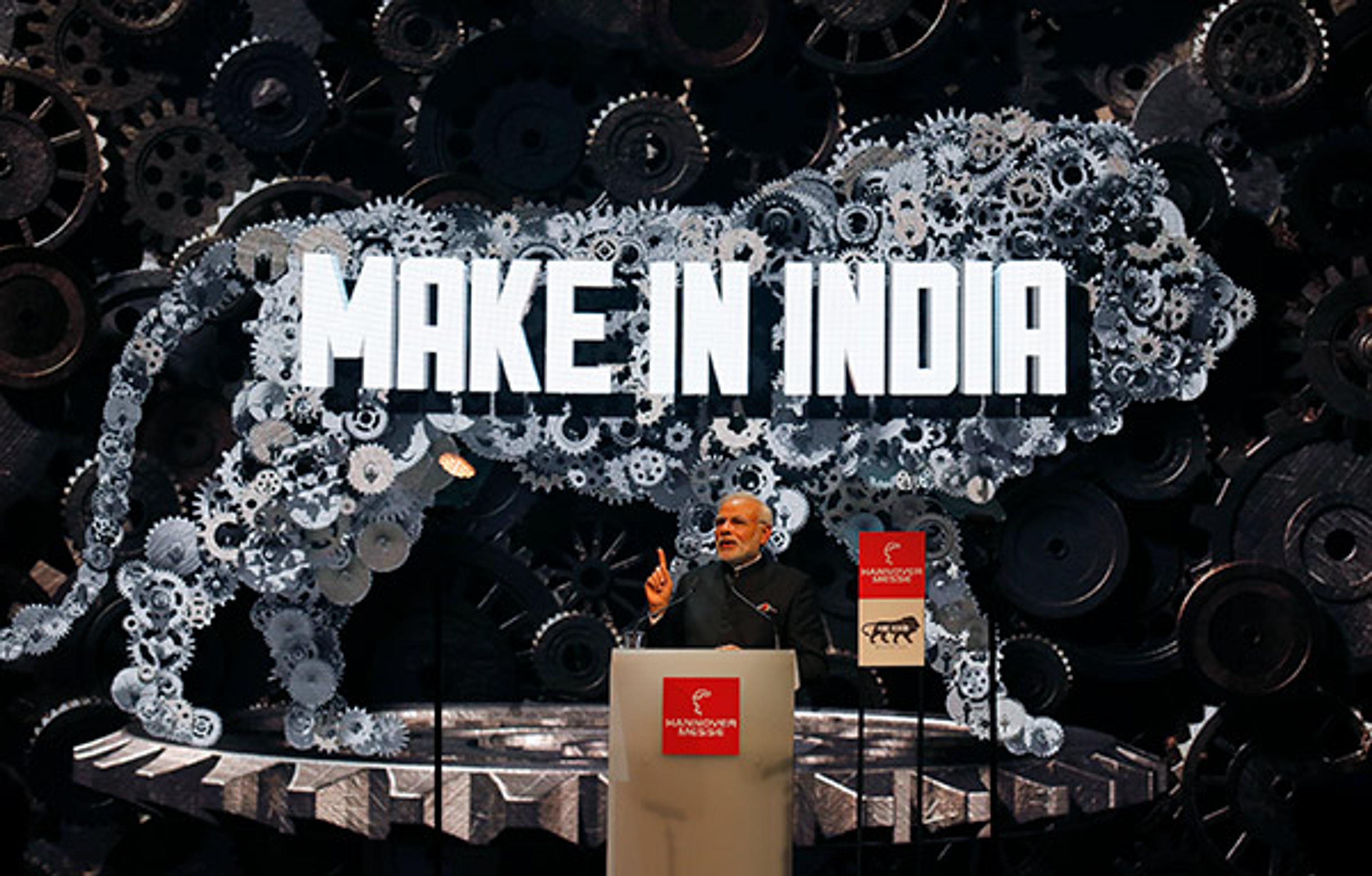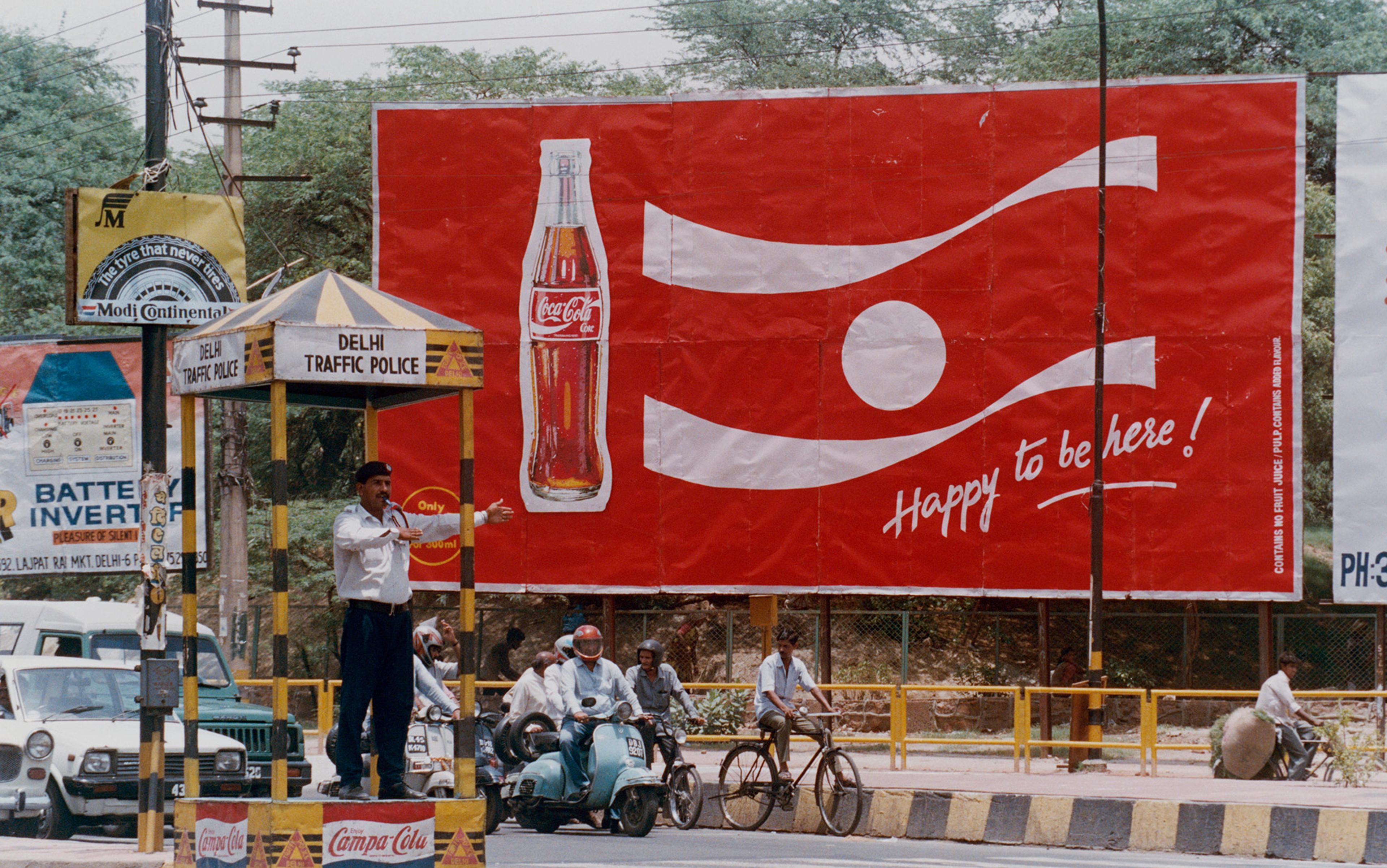The early 1990s was a moment of fragile hope and anxiety in India. The nation had just ‘opened up’ its economy to join the world of free markets, a post-Cold War ‘end of history’ global world. The seductive formula held out the promise of foreign investments, high economic growth, and of unleashing the caged spirit of Indian enterprise. It also promised more consumer choices to Indian citizens, dreams of a better life and, most of all, a chance to set the nation’s course to resplendent 21st-century futures. The forward march to market liberalisation also entailed breaking away from India’s legacy of economic nationalism: the anticolonial economics of swadeshi (literally, ‘of one’s own nation’) or self-reliance. Swadeshi had dominated Indian economic policy and thinking since national independence, and it prioritised autonomy over the nation’s resources. The boycott of foreign-made goods was the most popular expression of swadeshi politics.
New Indian economic policy in the 1990s threw open the consumer market to foreign goods. Swadeshi-school economic thinkers termed it the ‘coca-colonisation of India’. In this dramatic transition to free-market capitalism, Coca-Cola became both a sign of the worldly pleasures now available to Indian consumers, and of the treachery of ‘selling out’ to foreign corporations. In 1977, Coca-Cola had been banned by the Indian state. The company was subsequently turned into a nationalist venture that sold an Indian brand of soft drinks called Thums Up. By the 1990s, Coca-Cola was not only back in the newly liberalised India, it bought the Indian brand to expand its operations in the market. The corporate sale of Thums Up to Coca-Cola illustrated how liberalisation and globalisation had displaced the principles of swadeshi economic nationalism. The free-market lobby, it was ruefully remarked, had ‘sold out to big business’ and turned its back on India’s anticolonial dream of economic Independence.
Though advocates of swadeshi as well as socialist activists contested liberalisation in the early 1990s, few grasped the full consequences of India’s transition to free-market capitalism. Liberalisation of India proved more than the question of foreign consumer goods or foreign takeover of companies that socialist and swadeshi advocates alike aimed to prevent. In the 21st-century global economy, the nation-state is itself undergoing transformation into an enclosure of global capital. In the 1990s, India began courting foreign capital to rejuvenate its economy through global investment programmes. What initially began as a push to sell ‘Made in India’ goods in global markets would soon turn into a ‘Make in India’ project seeking to recast the country as a veritable ‘factory of the world’ for global manufacturing. At the turn of the millennium, a historic publicity campaign portrayed India as an investment hotspot in the global markets. The campaign name was ‘India Shining’, and it was an accurate description of the postcolonial country’s transition to capitalism.

India’s prime minister Narendra Modi speaks during the opening ceremony of the world’s largest industrial technology fair, the Hannover Messe, on 12 April 2015 in Hanover, Germany. Photo by Wolfgang Rattay/Reuters
By offering India as a refuge for global capital made available through state-led investment programmes, the metaphor signalled a deep transformation. The infusion of capital made India shine in the theatre of the world economy – or, in the language of policy experts, its structural adjustments and lowering of trade barriers were aided and abetted by global financial institutions (the IMF and the World Bank) and facilitated by the state. This move altered the old compact between nation and state. Once structurally adjusted, the nation became a site of production, its territory a reserve of untapped natural resources, its population a ‘demographic dividend’ that both produced and consumed, and its culture a unique brand identity. India Shining represented a nation and state bound to an optimistic vision of economic growth and prosperity, the erasure of colonial shame, and even the restoration of a golden, and mythical, Hindu past. Originally fashioned to help India acquire a unique cultural identity in the global economy, this soft-power mythology of the country as an ancient Hindu nation soon became a powerful tool in the religious nationalism of Hindutva. This great, ancient, pre-Muslim civilisation, Hindu nationalists insist, represents the authentic India.
This recent transformation of the nation-state in India provides another counterexample to the misguided promises that a flat world of free markets would make nation-states extinct. Proponents long imagined that globalisation – shorthand for unrestrained mobility of capital, goods, people and ideas – as a world-in-motion, an open-ended market trade sans barriers. National borders were to become superfluous. The story of globalisation itself has been told in the language of movements – flows, motions, networks, mobility, circulations and fluidity. The image is of perpetual motion. The India Shining campaign discloses how the nation-state not only defied the predictions of its end, but was undergoing a makeover to become a capitalist ‘growth story’ in the global economy.
This shift becomes especially apparent in the old developing world, which, at the turn of the millennium, global financial institutions and investors imagined as a frontier of emerging markets. The turning point came in the 1990s. That is when the ‘triumph of liberalism’ in Euro-America energised the contentious project of neoliberal reforms in the Global South. With the counterweight of communism gone, liberal economic reformers pitched their plans as the only viable future for the developing world. Financial institutions and think tanks, such as the Foreign Policy Centre launched in 1998 by Britain’s prime minister Tony Blair and his foreign secretary Robin Cook, encouraged countries of the Global South to make structural adjustments and ‘open up’ their markets to foreign capital investments. This formula promised economic prosperity to the postcolony and a future as a great power, to win a seat at the table of global politics. India stood as the forerunner among the postcolonial nations that cautiously embraced the liberal project of capitalist reforms. Given its sheer complexity and size in the world economy, India’s decision to embrace market liberalisation served as a compelling example. Among policymakers and journalists, the ‘India Story’ became a shorthand for the promised good times to citizens and profits to investors of the country’s turn to neoliberal economics.
The India Story raises the question: what does it mean to love the nation in the 21st century? To ask this question already seems an aberration, given that the ideal of the nation is at odds with commodification and market transactions. After all, Indians have long imagined the nation as sacred, a dynamic moral-spiritual project with a common history of love and suffering. The origins of 19th-century cultural nationalism in Europe lay in the idea of nations as ‘organic beings, living personalities’ that demanded sacrifice and devotion, a ‘special kind of love’ that exceeded all others to sustain this virtual person. Nationalists presumed the nation to be a unique being with an inalienable civilisational essence and a timeless history, and with its territory personified as a sacred being. To love the nation, then, was to celebrate the geist (spirit) of the volk (people), the national romance that embraced natural landscapes and their ethnic inhabitants. The ultimate expression of nationalism was martyrdom for its cause. For Indians engaged in the anticolonial struggle, the figure of the mother goddess, Bharat Mata (Mother India), a feminine embodiment of the nation’s territorial expanse, served as the sacred object of devotion and sacrifice.
Note the near-absence of Muslim figures or symbols in the Brand India imagery
So how could the sacred nation be put at the disposal of investors in the marketplace? What renders the nation transcendental and open to exchange in the market is imagining it as a living organism, a unique being that can be dressed up as a branded investment destination. That its landscape holds untapped natural resources and its people are consumers and producers enabled the state to represent the nation’s cultural identity, turning it into a corporate brand identity. To love and be devoted to the nation, then, means to work to enhance the brand value and economic potential of the nation. It means adding value to the nation by projecting it as a profitable, market-ready investment destination. The logic of 19th-century cultural nationalism is turned upside-down: the nation’s market value as a profit-generating commercial enclosure becomes a mode of affirming the worthiness of the people (volk) as a great nation. The more the brand-new nation attracts and generates capital, the more it legitimises its aura, its claims of essence, its identity as the chosen people, and its natural ties with the landscape. The infusion of capital continually generates something that exceeds capital – the aura/spirit or the non-extractable difference that’s ploughed back to generate brand capital. In short, the cultural difference distilled into a corporate brand is put to work to generate capital, and capital in return enhances the claims of cultural uniqueness.
The commodification of the nation consecrates too the very idea of state sovereignty in ever-new forms: the visual power to celebrate the revitalised nation and to see and show the national territory and its population as valuable factors of production available to global capital. Consider the Brand India publicity material, which mostly appears as a repackaging of the familiar cultural exotica – from yoga to wildlife, from colourful festivals to Ayurveda – in global aesthetics for its consumers in India and the world. What is crucial to this cultural politics of brand-making is not just what’s inside the image-frame but what’s kept outside it: for example, the near-absence of Muslim figures or symbols in the Brand India imagery. If there’s an exception, it’s the presence of the Taj Mahal, the 17th-century Mughal monument built in Indo-Islamic style. This mausoleum is a permanent thorn in Hindu nationalist politics, but one that can’t easily be evicted from Brand India. The monument is India’s prime tourist attraction and a world heritage site that generates steady profits.
The logic of Brand India also extends to rearranging the sociopolitical landscape. Critical to this transformation is how brand-making opens up a fractious politics of visual re-territorialisation of the nation. Who are the chosen people who inhabit the visual surface of the nation-brand? A form of public recognition of the nation’s cultural essence, that unique visual representation acquires legitimacy when the state sanctions it. It is here that the Brand India imagery assumes significance – the predominant choice of pre-Muslim Hindu cultural practices in the image-frame eventually becomes the cultural mainframe of the nation. The celebratory representation of cultural Hinduism as symbolic of modern India marginalises all other religious groups and the multicultural identity of postcolonial India. As a result, the ideas ‘India’ and ‘Hindu’ are increasingly conflated in the public imagination. (For example, India’s prime minister Narendra Modi recently laid down the foundation of the country’s new parliament in a ceremony with mostly Hindu rituals.) The secular and egalitarian roots of the foundational anticolonial nationalism are giving way. Taking its place is unabashed Hindu nationalism that neither brooks dissent nor is willing to share power with the minority groups.
By producing images of the nation and its culture, and marketing them to global investors, the state asserts its power. Historians of nation-states have a saying: states make (or, in this case, re-make) nations, not the other way around. State power demarcates the ‘domestic’ affairs of the nation as a forbidden territory for external actors. But the tacit bargain is that the state manages and facilities capital mobility and, in return, retains the power to rearrange the domestic sphere without external interference or sanctions.
This transaction became apparent in August 2019 when the Indian government revoked the special autonomous status of Kashmir. Two developments took place simultaneously: the region was ‘shut down’ in a curfew with an internet blackout to stymie political protests and at the same time ‘opened up’ for business. The revocation was accompanied by an official announcement of an ‘Investor Summit’ that invited investors to witness first-hand ‘the business-friendly policies of the Government, assess infrastructure, natural resources, raw material, and skill and un-skilled manpower and identify business opportunities in the State’.
It’s hardly a surprise, then, that India’s march to become the ‘factory of the world’ – a global space of production that contains natural resources, cheap skilled labour, technology as well as a vast consumer market – is an essential partner with pro-capital Hindu majoritarianism. At the heart of this alliance is the pursuit of economic growth, a project that calls for discipline and obedience to the strongman leader who ‘means business’ in more ways than one. This strongman appeal of Modi as a hyper-masculine Hindu leader is how he first attracted and won support from captains of industry. Capital has long favoured authoritarian leaders who can capture resources and put them at the disposal of investors, and also produce good news campaigns to celebrate the ‘growth story’ of the nation.
The advertisement sells India to global investors but barely mentions the country
This is where the domains of politics, economics and publicity come together to shape the contours of pro-capital Hindu nationalism. The special kind of love for the brand-new nation requires a steady channelling of positive, uplifting images into the global public sphere. It also means overlooking and countering negative images that might harm the nation’s brand value in the world. The need for consistent good news to keep optimism alive is at odds with the requirements of democracy. The heart of democracy is dissent, a practice that involves criticism, disagreement and even expressions of disobedience. This contradiction has created a rupture and a new kind of Indian dissident through the logic of the brand: the anti-national, the one who corrodes the brand value of the nation by exposing the negatives, the communal violence, caste atrocities and poverty otherwise buried beneath the propaganda.

An advertisement from the India Shining campaign. Image supplied by the author
In the spectacular catalogue of Brand India, one unusual image stands out. It’s an advertisement that sells India to global investors but barely mentions the country. It captures a key transformative moment in the making of the 21st-century nation and its nationalism from the embers of globalisation. Look at the image frame. Designed in early 2004, the advertisement reproduces an old drawing titled ‘Columbus Discovers America, 1492’ with a bold new caption: ‘The last time we held so much promise, Columbus discovered America.’ It features an artistic portrayal of the arrival of Christopher Columbus on the shores of the New World. Columbus and his crew appear overjoyed and exhausted, thankful for having found the land of promise after a long and arduous journey. Text accompanying the image reads:
When Columbus set sail to find the rich spices of our land, destiny had other plans. Instead of finding us, he discovered America. Years later, modern-day explorers have got our incredible land back on their maps. Because today we are among the globe’s fastest growing economies … And opportunities are endless. For global corporate captains, investors, marketers, exporters and tourists, the weather today is just perfect to sail for our beautiful shores. Our country is shining, and you’ve never had a better time to shine brighter.
At the bottom appear the national flag and the official emblem of the India Shining campaign.
This campaign and its poetic invitation to ‘sail for our beautiful shores’ was designed to draw the attention of a powerful consumer group – global investors and policymakers – to India. It was witty and effective in the speculative arena of finance capital where postcolonial nations turned emerging markets competed for foreign investments. The sales pitch was direct: Indian commodity is once again available in the global marketplace. The visual sign of India’s ongoing commodification into an investment destination was the presence of Columbus. Here, Columbus served to rekindle the old desire for a legendary India that had once moved Europeans to undertake a dangerous expedition across the ocean. India Shining promised investors that they could succeed where Columbus and other Europeans of the ‘age of discovery’ had failed. They could tap into India’s great resources and wealth. India might have eluded Columbus, but it was now inviting capital to return to the great prize.






